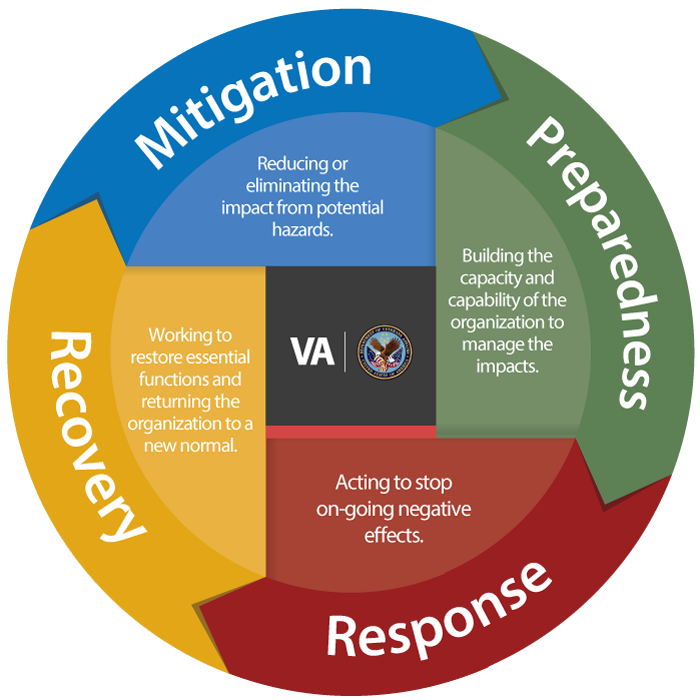VHA Office of Emergency Management
Comprehensive Emergency Management Program
The comprehensive emergency management principles of mitigation, preparedness, response, and recovery is a phased disaster life-cycle model used to help ensure preparedness for and response to disasters.
Veterans Integrated Service Network (VISN) and Veterans Affairs Medical Center (VAMC) emergency managers use these principles to ensure their facilities and staff are able to respond to and recover from evolving threats and hazards.
4 Phases of Emergency Management
- Preparedness encompasses those strategies that the VHA health care system can employ to strengthen the facilities ability to manage the impacts of a disaster. Examples of preparedness strategies used in VHA healthcare include ensuring facilities are able to accommodate additional patient visits that often accompany an emergency or disaster.
- Mitigation encompasses those strategies that the VHA health care system can employ to reduce a potential hazard’s severity and impact before the incident even occurs. In some instances, mitigation measures can even prevent the incident from occurring. Examples of mitigation strategies used in VHA healthcare include ensuring facilities have back up for power, water, computer, data management and communication systems or that facilities are safe structurally.
- Response encompasses strategies required to save lives, protect property and the environment, and meet basic human needs after an incident has occurred. Examples of response strategies used in health care include the establishment of Alternate Care Sites. Alternate Care Sites are temporary medical facilities established when access to the VA medical clinics is impeded due to incidents or disasters. These sites are a means of providing medical services within an impacted area due to a disaster.
- Recovery encompasses those strategies required to assist the impacted community’s return to normalcy as soon after a disaster as possible. Some examples of recovery strategies include ensuring disrupted health care facilities are able to see patients again or the provision of ongoing behavioral health care as a result of the disaster.

VHA Office of Emergency Management (OEM) programs help to facilitate the delivery of continuity of health care. During times of war, terrorisms, national emergencies, and natural disasters, VHA OEM programs coordinate efforts to ensure continued service to Veterans, as well as support to national, state, and local emergency management, public health, safety, and homeland security efforts.
VHA serves as a support organization to the National Disaster Medical System (NDMS). The NDMS is a federally coordinated initiative to assist state and local responses to the medical and public health effects of major disasters and emergencies, as well as support to the military medical system in caring for casualties resulting from military conflicts.
VHA OEM functional areas
- Disaster Logistics Management VHA OEM owns and maintains a wide range of resources that can be used to manage or support the response to a disaster. Disaster Logistics Management manages, maintains, and coordinates VHA OEMs resources for use by VISNs, VAMCs, or NDMS when there is a national disaster. The resource inventory includes Command Vehicles that provides mobile office space, resilient communications, and an operational platform for up to nine people or Mobile Medical Units that can delivery primary care and other services to communities.
- Operations VHA OEM’s Field Operations program is comprised of staff located throughout the nation providing direct assistance to VISN and VAMC comprehensive emergency management programs and oversees VHA's Federal Patient movement under the National Disaster Medical System (NDMS). Direct assistance can range from providing subject matter consultation, to emergency planning support, and in some instances helping or leading responses to emergencies and/or disasters.
- Support Operations VHA OEM’s Support Operations program provides the VHA OEM Watch, Disaster Emergency Medical Personnel System (DEMPS), and Clinical Deployment Teams (CDT). The Watch collects, analyzes, and disseminates information to a wide range of stakeholders. The information facilitates timely decisions by providing situational awareness and fully coordinated recommendations to senior leadership regarding the development of potential or emerging threats.
- Preparedness VHA OEM’s Preparedness program is comprised of efforts to facilitate VHA’s ability to respond to an emergency and or disaster. Preparedness efforts include planning for local and national disaster responses, training and exercising staff to ensure they know what to do when an event occurs, assessing VISN and VAMC programs to ensure that their programs are prepared to respond, and development of overarching VHA emergency management policy. We also work with other federal agencies to promote readiness for Veterans, VA staff and the general public.





















